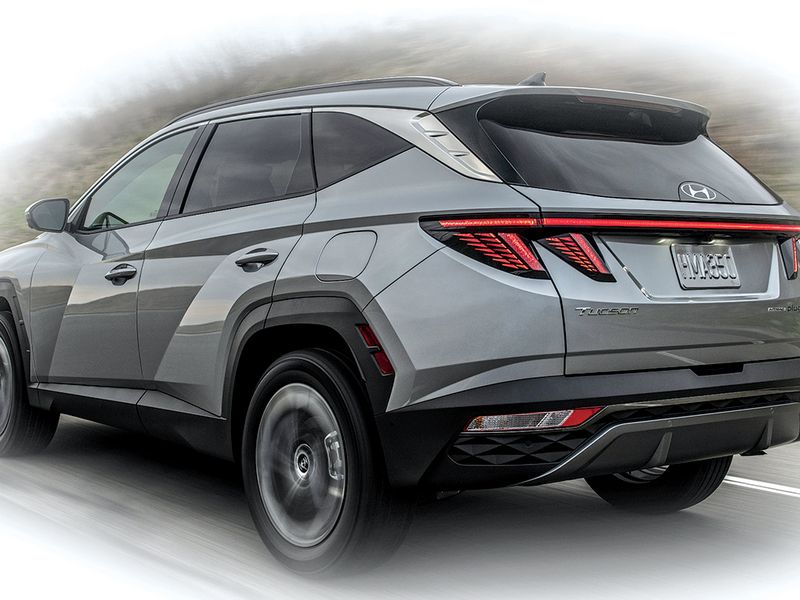
LOS ANGELES — Hyundai continues its heavy emphasis on new product as it gains U.S. market share and pledges to become a leader in hybrids, plug-in hybrids, battery-electric vehicles and hydrogen fuel cell technology.
The Korean brand’s approach going forward is to accelerate an “all of the above” philosophy to its vehicle lineup and trim offerings to take market share from Asian rivals such as Toyota, Honda and Nissan.
Unlike some other automakers, Hyundai is generally sticking with its core passenger cars in the coming years, along with an expanded crossover lineup and the launch this fall of its EV subbrand, Ioniq.
For the 2022 model year, there’s a new rugged XRT appearance trim for crossovers and an expansion of the track-ready N performance package to more models.
Accent: The subcompact sedan will return for 2022 with minimal changes. When Hyundai rolled out the entry-level Venue subcompact crossover in 2019, the automaker said it would continue to sell the Accent as long as there is demand. Given that the current-generation Accent is at the end of its life cycle, it’s likely to be discontinued in the second half of 2022. For the coming model year, a manual transmission will no longer be an option.
Veloster: The funky hatchback, with one door on the driver’s side and two on the passenger side, is being discontinued for the 2022 model year, except for the track-ready N variant. Hyundai will sell a Kona N subcompact crossover this year with similar performance. That could end Veloster production entirely in 2022, since the Kona is a top seller for the brand.
Elantra: Redesigned for the 2021 model with a hybrid version for the first time, the Elantra carries over for 2022 with no major changes, with one exception: A track-ready N performance variant will go on sale in the fall. A freshen of the compact sedan is likely in 2023 and a new generation in 2025.
Ioniq hatchback: The compact Ioniq hybrid carries over for the 2022 model year, as does the plug-in hybrid. The EV version is discontinued after the 2021 model year. The Ioniq EV was Hyundai’s first electric vehicle when it arrived to a limited number of U.S. states for the 2017 model year. Given that Hyundai is creating a subbrand around the Ioniq name, the remaining versions of the hatchback are likely to be phased out in 2022.
Sonata: Redesigned for the 2020 model in gasoline and hybrid form, the midsize sedan carries over for the 2022 model with minor shifting of equipment on some trim levels. The N Line sport package adds a night edition with unique wheels, badging and spoiler. The Glowing Yellow paint option is dropped for the sporty trim. A freshen is likely in 2022 and a redesign in 2024.
Venue: The smallest and least expensive of Hyundai’s crossovers carries over for the 2022 model year with some minor trim adjustments. The Venue was new for the 2020 model year and is seen as a replacement for the Accent sedan in the near future. A freshen should come in the second half of 2022 for the Venue when the Accent is likely to be discontinued.
Kona: The larger of Hyundai’s two subcompact crossovers, the Kona was freshened this year as a 2022 model. The exterior styling is more crisp compared with the original version introduced as a 2018 model. An N Line trim was also added with the freshen. The Kona EV was also freshened and a track-ready Kona N is being added in the fall. A redesign is likely in 2023.
Tucson: A redesigned and significantly larger 2022 Tucson went on sale this year, adding hybrid versions for the first time. The regular hybrid is already on sale and the plug-in hybrid is now trickling into dealerships. The Tucson is expected to be offered with the XRT rugged appearance package to match the Santa Fe. A Tucson freshen is expected in 2024.
Santa Fe: The midsize crossover received a heavy freshen for the 2021 model that put it on a new platform and heavily updated the styling. The freshen enabled hybrid and plug-in hybrid drivetrains for the first time. The Santa Fe is the first Hyundai crossover to get the rugged XRT appearance package for the 2022 model year. A redesign should come in 2024.
Palisade: New for the 2020 model year, the hot-selling Palisade carries over for 2022 with new standard features, such as blind-spot collision avoidance assist. A freshen should come in 2023. Currently, the Palisade is sold only with a V-6 engine, but a turbocharged four-cylinder or a hybrid version could come when the vehicle is redesigned, likely in 2025.
Santa Cruz: The brand’s first pickup is now on sale for the 2022 model year. Based on the Tucson crossover, the Santa Cruz is likely to be freshened on the same cycle as the Tucson, in 2024. Hyundai has not said whether the Santa Cruz could come in a hybrid version, like its coming rival, the Ford Maverick. The Santa Cruz is also a future candidate for the XRT appearance package, which includes a more rugged look but no extra off-road hardware.
Ioniq 5: The compact crossover EV will be the first of Hyundai’s second-generation EVs to go on sale in the U.S. this year. It rides on a new dedicated electric platform, E-GMP. The first versions of the Ioniq 5 will have the larger of two battery options, with up to 300 miles of range on the EPA test cycle. A version with a smaller battery is now offered in other markets and should come to the U.S. in 2022, with around 220 miles of range. It should receive a freshen in 2024.
Ioniq subbrand: The Ioniq 5 will launch the Ioniq EV subbrand in the U.S. The next model will be a midsize car, the Ioniq 6 in 2023. The third will be the three-row Ioniq 7 crossover for 2024.